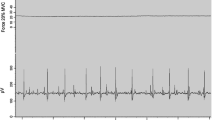Abstract
The amplitude and duration of motor unit action potentials, the rise time, peak tension, and half relaxation time of an isometric twitch, and forcevelocity relationship, and tetanic tension were measured at the beginning (fresh muscle) and at the end of a fatiguing isometric contraction at a tension of either 40 or 70% of the initial strength in the soleus (a slow twitch muscle) and the medial gastrocnemius (a fast twitch muscle) of the cat. These same parameters were also measured at set intervals following these contractions to assess their rate of recovery to pre-exercise values. At The end of a fatiguing contraction examined,V mx, twitch tension and tetanic tension, were all reduced while there was a prolonged twitch duration and duration of the motor unit action potential for both types of muscle. The height of the motor unit action potential was only marginally effected by muscle fatigue. Following the fatiguing contraction, the endurance required several hours to recover in the medial gastrocnemius muscle but recovered fully within 15 min after either tension in the soleus muscle. Tetanic tension and twitch tension both required less than 10 min for full recovery in the medial gastrocnemius muscle but recovered fully to the pre-exercise values within 3 min following fatiguing isometric contractions in the soleus muscles.V mx, and the height and duration of the motor unit action potential both recovered within 1 min following the end of the exercise.
Similar content being viewed by others
References
Ariano M, Armstrong RB, Edgerton VR (1973) Hinlimb mucle fiber populations in five animals. J Histochem Cytochem 21:51–55
Bartky SH (1965) Fatigue, mechanism and management. Charles C. Thomas, Springfield
Bigland B, Lippold OC (1954) Relationship between force, velocity and integrated electrical activity in human muscle. J Physiol (Lond) 123:214–224
Dawson J, Wilkie D, Gadian D (1978) Studies of biochemistry of contracting muscle using31P nuclear magnetic resonance. In: Sugi H, Pollack G (eds) Cross bridge mechanism in muscle contraction. University Park Press, New York
Fink R, Luttgau HD (1976) An evaluation of membrane constants and potassium conductance in metabolically exhausted fibers. J Physiol (Lond) 263:215–239
Fitts R, Holloszy J (1971) Contractile properties of cat soleus muscle; effects of training and fatigue. Am J Physiol C86–C91
Ikai M, Steinhaus A (1961) Some factors modifying the expression of human strength. J Appl Physiol 16:157–163
Karlsson J, Funderburk Essen B, Lind AR (1975) Constitutents of human muscle isometric fatigue. J Appl Physiol 38:208–211
Krnjenic K, Miledi R (1959) Presynaptic failure of neuromuscular propagation in rats. J Physiol 149:1–22
Lind AR, (1959) Muscle fatigue and recovery from fatigue induced by sustained isometric contractions. J Physiol 147:162
Lind AR, Petrofsky JS (1979) Amplitude of the surface electromyograms during fatiguing isometric contractions. Muscle and Nerve 2:257–264
Marsden CD, Meadows JC, Morton PA (1971) Isolated single motor units in human muscle and their rate of discharge during maximal voluntary effort. J Physiol London 12P–13P
Merton PA (1954) Voluntary strength and fatigue. J Physiol 246:549–569
Milner-Brown HS, Stein RB (1975) The relation between the surface electromyogram and muscular force. J Physiol (Lond) 246: 549–569
Mortimer JT, Magnusson R, Petersen I (1970) Conduction velocity in ischemic muscle; effect on EMG frequency spectrum. Am J Physiol 217:1324–1329
Petrofsky JS (1978) Control of the recruitment and firing frequency in electrically stimulated muscle in the cat. Med Biol Eng 16:302–308
Petrofsky JS, Lind AR (1979) Isometric endurance in fast and slow muscle in the cat. Am J Physiol 236:C185-C191
Petrofsky JS, Phillips CA (1979) Determination of the contractile characteristics of the motor units in skeletal muscle through twitch characteristics. Med Biol Eng Comput 17:525–533
Petrofsky JS, Phillips CA (1979) Constant velocity contractions in skeletal muscle in the cat. Med Biol Eng Comput 17:583–592
Petrofsky JS, Phillips CA (1980) The influence of recruitment order and fibre composition on the force-velocity relationship and fatiquability of skeletal muscles in the cat. Med Biol Eng Comput (in press)
Petrofsky JS, Guard A, Phillips CA (1979) The effect of muscle fatigue on the isometric contractile characteristics of skeletal muscle in the cat. Life Sci 24:2285–2292
Petrofsky JS, Weber C, Phillips CA (1979) Electrical and mechanical correlates of fatigue in skeletal muscle. Physiologist 22:101
Rack PMH, Westbury DR (1969) The effects of length and stimulus rate on tension in the isometric cat soleus muscle. J Physiol (Lond) 204:443–460
Stevens JA, Taylor A (1972) Fatigue of maintained voluntary muscle contractions in man. J Physiol 220:1–18
Author information
Authors and Affiliations
Rights and permissions
About this article
Cite this article
Petrofsky, J.S., Weber, C. & Phillips, C.A. Mechanical and electrical correlates of isometric muscle fatigue in skeletal muscle in the cat. Pflugers Arch. 387, 33–38 (1980). https://doi.org/10.1007/BF00580841
Received:
Accepted:
Issue Date:
DOI: https://doi.org/10.1007/BF00580841




